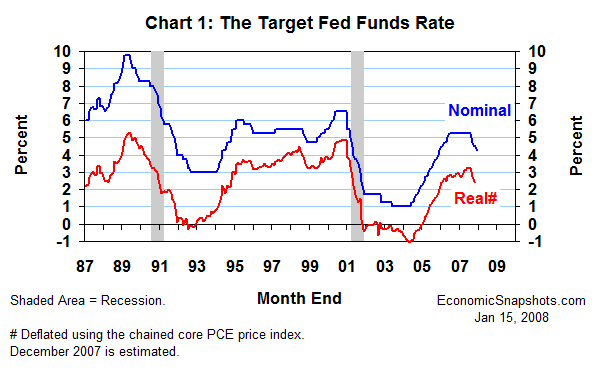
| Back to Index |
January 15, 2008 – During the last four months, the FOMC has reduced its target Fed funds rate by a total of 100 basis points, to 4.25% (Chart 1).

This easing activity was spread over the FOMC’s last three regular monetary policy meetings, with target Fed funds cuts of 50 basis points in September and 25 basis points each in October and December.
Fed Chairman Bernanke said in a speech last week, “…in light of recent changes in the outlook for and the risks to growth, additional policy easing may well be necessary.”
Bernanke reminded us that the FOMC’s future policy decisions will depend, as always, on “incoming information”. Also, the FOMC hasn’t forgotten its commitment to price stability. Subject to those qualifications, “we stand ready to take substantive additional action as needed to support growth and to provide adequate insurance against downside risks.”
Bernanke’s comments lend support to the case for a relatively aggressive 50 basis point reduction in the target Fed funds rate at the FOMC’s next monetary policy meeting on January 29-30.
Today’s economic data – which showed weak growth in December retail sales and tolerable growth in December core producer prices – continue to favor that 50 basis-point target Fed funds cut.
Bernanke described a chain of causality running from the downturn in U.S. housing demand to last year’s meltdown in the sub-prime mortgage sector to a broader credit crunch that threatened to derail the entire economy. The FOMC’s recent easing actions were meant to offset this broader downside risk to real economic growth.
“Recently, however, incoming information has suggested that the baseline outlook for real activity in 2008 has worsened and the downside risks to growth have become more pronounced.”
Bernanke said weaker-than-expected housing demand played a role in this diminished “baseline” outlook.
In addition, “a number” of negative developments (including “higher oil prices, lower equity prices and softening home values”) now seem likely to result in slower real consumption growth than the FOMC had previously forecast “as we move into 2008”.
The fact that the economy’s downside risks have become “more pronounced” suggests that FOMC members have become more worried about the possibility of a recession this year.
Bernanke listed two key threats to real economic growth.
First, conditions in the financial markets remain “fragile”. In particular, FOMC members fear that bad news about either the economy or the financial markets might trigger more market-driven tightening in household and/or business credit conditions. (In short, the credit crunch might get worse.)
Second, the FOMC majority had been counting on growth in jobs and labor income to keep real consumption growing at a “moderate” pace this year. Thus, the unusually large 0.3 percentage point increase in the December unemployment rate was very unwelcome news.
“It would be a mistake”, Bernanke said, “to read too much into any one report. However, should the labor market deteriorate, the risks to consumer spending would rise.”
Consumption accounted for a big 70% of U.S. GDP, as of Q3 last year. There would be very little hope of avoiding a recession this year without consumption growth.
Suzanne Rizzo